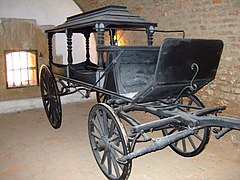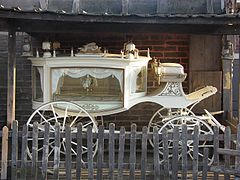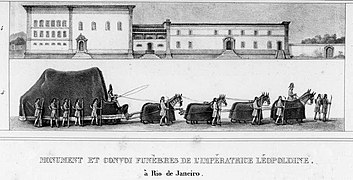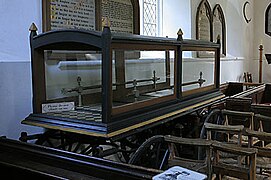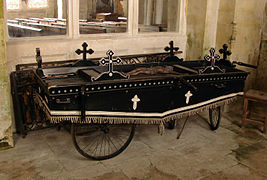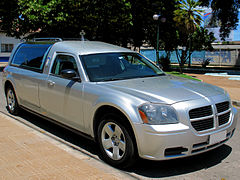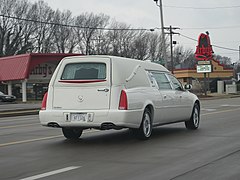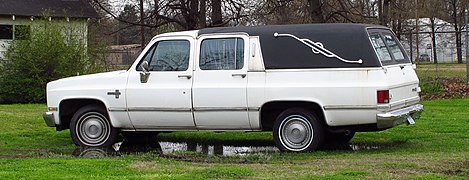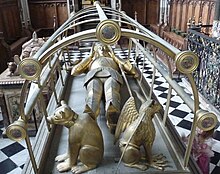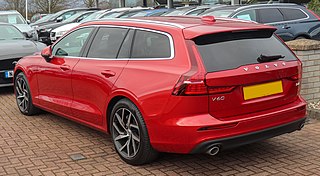
A station wagon or estate car, is an automotive body-style variant of a sedan with its roof extended rearward over a shared passenger/cargo volume with access at the back via a third or fifth door, instead of a trunk/boot lid. The body style transforms a standard three-box design into a two-box design—to include an A, B, and C-pillar, as well as a D-pillar. Station wagons can flexibly reconfigure their interior volume via fold-down rear seats to prioritize either passenger or cargo volume.

A flower car is a type of vehicle used in the funeral industry of the United States, frequently under the Cadillac brand. It is used to carry flowers for the burial service, or sometimes to carry the coffin under a bed of flowers. Built on the same commercial chassis as a hearse, the flower car has half-height rear bodywork on the rear similar to a pickup truck bed. The bed contains a liner to hold the flowers, normally built of stainless steel to resist rust. Some flower cars have a raised, flat tonneau cover across the bed at the top, upon which the flowers sit; the center portion sometimes is designed to raise and lower, hydraulically or by hand. If the flower car is designed to carry a casket, it will be stored under the tonneau cover in the space beneath, behind the opening rear gate.
There are many types of car body styles. They vary depending on intended use, market position, location, and the era they were made.

The first call vehicle is a vehicle used in the funeral service industry. This type of vehicle is used to pick up the remains of a recently deceased person, and transport that person to the funeral home for preparation. This initial pickup is called the "first call", hence the name of these vehicles. While some funeral homes will use their hearse for these initial pickups, having vehicles specifically for first calls and using the hearse solely for funerals reduces wear on hearses and makes the first call process more discreet. Sometimes, when the procession portion of funeral protocol comes into play, First Call vehicles double as funeral yield vehicles, which grants the procession the right of way.

Shooting-brake is a car body style which originated in the 1890s as a horse-drawn wagon used to transport shooting parties with their equipment and game.

A fastback is an automotive styling feature, defined by the rear of the car having a single slope from the roof to the tail.

The Cadillac Commercial Chassis is a chassis that was built by the Cadillac division of General Motors. Produced from 1931 to 1979, the Commercial Chassis was constructed as an incomplete vehicle intended for use by coachbuilders for final assembly and fitment of bodywork. Produced on the D platform throughout its entire production, the Commercial Chassis was initially derived from the Series 355, shifting to the Series 75 from 1936 onward.
The Wayne Corporation was an American manufacturer of buses and other vehicles under the "Wayne" marque. The corporate headquarters were in Richmond, Indiana, in Wayne County, Indiana. During the middle 20th century, Wayne served as a leading producer of school buses in North America.

The Ectomobile is a fictional vehicle from the Ghostbusters franchise. It appears in the films Ghostbusters (1984), Ghostbusters II (1989), the reboot, where in it appears as a hearse as opposed to the original's ambulance, Ghostbusters (2016), Ghostbusters: Afterlife (2021), Ghostbusters: Frozen Empire (2024), in the animated television series: The Real Ghostbusters, Slimer! and Extreme Ghostbusters, and in the video games Ghostbusters: The Video Game and Beeline's Ghostbusters iOS app.

Fleetwood Metal Body was an automobile coachbuilder formed on April 1, 1909. The company name was derived from Fleetwood, Pennsylvania, home of the company at the start, and lived on for decades in the form of the Cadillac Fleetwood and various Fleetwood trim lines on Cadillac cars. As of 2022, the remaining original buildings of Fleetwood Metal Body are undergoing restoration and renovation into loft-style apartments.
Superior Coach was a coachbuilder in the American automotive industry. Founded in 1909 as the Garford Motor Truck Company, Superior is best known for constructing bodies for professional cars (hearses) and school buses. Following major downturns in both segments in the late 1970s, Superior was liquidated by its parent company in 1980. From 1925 to 1980, the company was based in Lima, Ohio.

A combination car was a vehicle that could serve either as a hearse or as an ambulance, and had the capability of being swapped between those roles without much difficulty. This hybrid usage of the cars reflects an era when funeral homes offered emergency ambulance service in addition to their primary trade, especially in smaller towns and rural areas.
A professional car is loosely defined as a vehicle based on a special long wheelbase commercial chassis and sometimes, though rarely, on modified passenger car chassis, for use as a hearse, flower car, service car, ambulance, limousines or for a combination of purposes. The term is mostly used in the United States.

The Cadillac V8, introduced as the Type 51, is a large, luxurious automobile that was introduced in September 1914 by Cadillac as a 1915 model. It was Cadillac's first V8 automobile, replacing the four-cylinder Model 30, and used the all new GM A platform for the entire series shared with all GM division brands using a 122 in (3,099 mm) wheelbase, while a 145 in (3,683 mm) chassis was offered separately to be used for custom coachwork. The Types 53, 55, 57, 59, and 61 were introduced every year through 1923 with yearly improvements until an all new platform was substantially updated and introduced as the V-63 using the business philosophy called planned obsolescence. It was built at the Cass Street and Amsterdam Avenue factory in Detroit, with the coachwork provided by Fisher Body. The chassis could be purchased separately and sent to the clients choice of coachbuilder optionally.

The Cadillac V-63 is a large luxury automobile that was introduced in September 1923 by Cadillac as a 1924 model, replacing the previous Type 61. It used the GM C platform and was replaced by the Cadillac Series 355 in 1931. It retained the name Cadillac V8 introduced with the previous generation Cadillac Type 51.

Coleman Milne is a coachbuilder in the United Kingdom that specialises in converting cars into funeral vehicles, stretched limousines, preparation of police vehicles and other specialist vehicles. Coleman Milne creates, builds, and sells hearses and limousines in the UK.
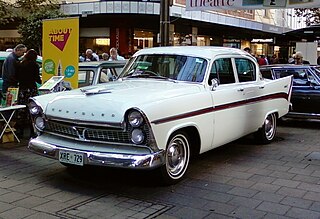
The Chrysler Royal is an automobile which was produced by Chrysler Australia from 1957 to 1963. After investing in tooling to stamp body panels for the 1954 P25 series Plymouth locally, and with Chrysler headquarters in Detroit unwilling to assist in the costs of retooling for the new US models, Chrysler Australia made the decision to develop their own range, using as much of the existing tooling as possible, whilst also realising that the new car had to appear as different as possible. The doors and basic structure of the P25 sedan was retained, and with input from Australian and American Chrysler designers, the 1955 US Plymouth front sheetmetal was adapted to the P25 body and the rear quarter panels redesigned. They also added a wraparound rear windscreen, which caused development problems with Pilkington Glass, the Australian suppliers, who struggled to get the correct curved shape.

The Cadillac Series 355 was a V8-powered luxury car manufactured by Cadillac from 1931 until 1935. It was offered as a 2-door club coupe, 2-door convertible, 4-door convertible, 4-door sedan, 4-door town car, and 4-door limousine. It provided a range of Cadillac below the maker's larger V-12 and V-16 lines. It was succeeded by the Cadillac Series 70/75.

Saoutchik was a French coachbuilding company founded in 1906 and based in Neuilly-sur-Seine near Paris. The company was one of the best-known coachbuilders in France in the 1920s and 1930s and, together with Figoni et Falaschi and Franay, is considered the most important representative of the “Baroque” style in French coachwork in the 1930s and 1940s.



